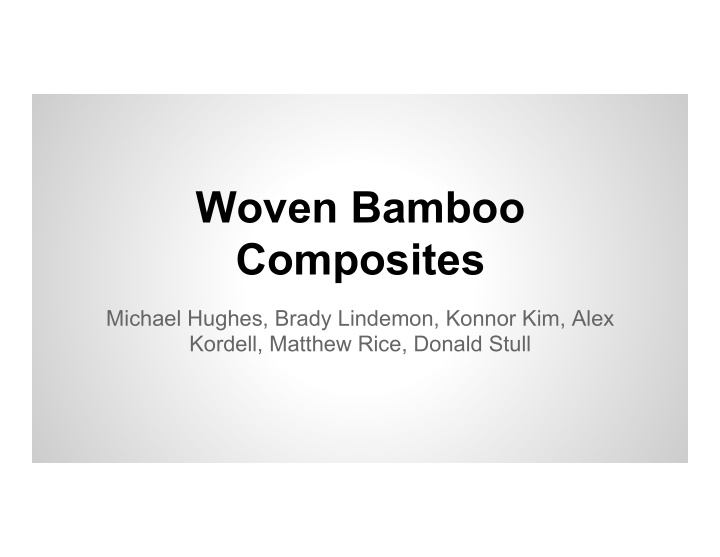



Woven Bamboo Composites Michael Hughes, Brady Lindemon, Konnor Kim, Alex Kordell, Matthew Rice, Donald Stull
Outline ● Introduction ● Motivation ○ What will be designed ● Materials Science Link ○ Properties ○ Structure ○ Processing ● Environmental Impact ○ Renewable Resource ○ Energy Cost ● Simulations ○ FE model ○ Results ● Prototype ○ Fabrication Method ○ Testing ○ Results and Analysis ● Conclusion
Introduction ● Composites often used for high strength to weight ratio. ● Carbon Fiber popular material for woven and unwoven fiber reinforcement. ● Problems due to cost and environmental concerns. ● Bamboo proposed as alternative. ● Investigation of Bamboo by Figure 1: Bamboo Stalks physical and computational source:www.ignorancia.org experimentation.
Motivation ● Carbon Fiber Woven composites ○ High Strength ○ Low Weight ○ High Fatigue Lifetime ● Problems ○ Expensive ○ Derived from Petroleum products ○ High Energy cost to produce ● Proposed Solution: Replace Carbon Fiber weave with woven Bamboo Fibers
Environmental Impact ● Energy cost of Carbon Fiber: 420MJ/ kg. ● Calculated cost of Bamboo Fibre Weave: 72MJ/kg. ○ Bamboo cost is bench cost, would decrease for large scale manufacturing. ● Lower energy mean lower. greenhouse emissions for energy. ● Composite derived from natural crop means it is renewable. Figure 2: CO 2 emissions by year Source: epa.gov/climatechange
Relation to MSE ● Properties: Composite Materials ○ Composed of Matrix material and reinforcement particles or fiber. ○ Allows limited control of stiffness and ductility of material. ■ Controlled by volume fraction of matrix and reinforcement. Ec = Ef*Vf+Em*Vm Equation 1: Elastic Modulus of a composite ● Structure: Woven Layer ○ Designed composite more complicated due to woven structure. Source: Fundamentals of Materials Science, Callister ○ Theoretically, stronger material due to increased displacement resistance from the weaving.
Finite Element Modeling ● Method for solving Partial Differential Equations (PBEs). ● Subdivides larger section into smaller sections that allow approximation of larger cumulative solution. ● Allows analysis of complex geometries. ● Construction of Elements using nodes. ○ Discrete points in structure that define elements and can be controlled. Called Meshing. ● Need to define proper boundary conditions. ○ Model dependent.
Building Finite Element Model ● Top Down Model using TexGen. ○ Creates desired geometry. ■ Space with defined pionts. Each of which are identified as either matrix or yarn. ○ Manual editing of faces and contract regions. Figure 3: Generic 2D plane weave ○ Importing of material created with TexGen properties.
Building Finite Element Model cont. ● Have Model, but not Finite element. ○ Meshing: Breaks geometry into discrete elements defined by nodes. ○ Different element types depending on the geometry of the element. ● Boundary Conditions: ○ Restricts the Models Degrees of Freedom. ○ Boundary Conditions of woven model. ■ Corner nodes and midpoint nodes of each face set to deform equally and opposite. ■ Setting these conditions also results in periodic boundary conditions.
Building Composite from Unit Cell ● Have a Unit Cell, but want to iterate to make full composite structure. ● Periodic boundary conditions allow copying of cell, as ending face of original cell becomes the beginning face of the next unit cell. ● ANSYS Script produces copy of current structure in any axial Figure 4: FE Model direction.
Testing of Modeled Composite ● Tensile Test: ○ Fixing of one face via constant equation. ○ Application of unidirectional force on opposite face. ○ Resulted deformation of model. ■ Had to use small iterative forces to keep Figure 5: FEM model static. images of Tensile Test
Fiber Separation • Harvested bamboo from a local garden • Bamboo was split into sections and soaked in 0.1 M NaOH for 72 hours to aid in the delignification of the bamboo due to time concerns. • The sections were soaked in water for 3 hours and rinsed several times to remove any remaining Figure 7: Bamboo fibres drying NaOH. • Sections were dried at 120 C for 2 hours and then air dried for five days before separation of the fibers occurred. • A roller mill was used to splinter the bamboo sections into fiber clusters; these were then further separated manually into single fibers. Figure 8: Dried fibers ready to be woven
Making the Composite • The fibers were organized by size and grouped into bundles of eight to be woven into the mat. • The weave was then inserted Figure 9: Woven Bamboo mat into a 3D printed mold filled with epoxy and allowed to cure for 24 hours. • We made similar samples using Figure 10: Composites a carbon fiber weave as well as just epoxy for comparison.
Testing ● Tested our composite material using a tension test. o Utilized digital image correlation to measure strain. ● Wanted to do a 3 point bend Figure 11: Prepped composites test as well but our fiber volume fraction prevented us. Figure 12: Composite in Tensile Test
Testing Results ● Tensile Tests performed at Army Research Laboratory ● Elastic Modulus values: ○ Carbon Fiber: 11.73 ○ Bamboo: 29.73 MPa ○ Epoxy: 35.463 MPa ● Ultimate Tensile Strength ○ Carbon Fiber: 7.1607 MPa ○ Bamboo: 1.235 MPa ○ Epoxy: 1.37 MPa Figure 13: Tensile Test of Samples
Testing Results cont. ● Due to budgetary concerns we had to settle on a non ideal epoxy. o Led to delamination of our sample. Figure 14: Example of Delamination
Conclusion ● Bamboo composites are a promising future renewable material. ● Need more extensive modeling efforts to determine ideal weave properties, possibly utilizing bottom up approach for more controlled model. ● Established proof of concept with FE model. ● Better fabrication method using vacuum bagging to make multiple layer composite.
Recommend
More recommend